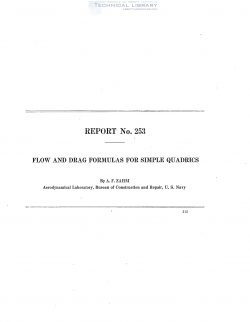naca-report-253

- Version
- 127 Downloads
- 1.41 MB File Size
- 1 File Count
- August 25, 2016 Create Date
- August 25, 2016 Last Updated
National Advisory Committee for Aeronautics, Report - Flow and Drag Formulas for Simple Quadrics

In this text are given the pressure distribution and resistance found by theory and experi-
ment for simple quadrics fixed in an infinite uniform stream of practically incompressible fluid.
The experimental values pertain to air and some liquids, especially water; the theoretical refer
sometimes to perfect, again to viscid fluids. For the cases treated the concordance of theory
and measurement is so close as to make a resume of results desirable. Incidentally formulas
for the velocity at all points of the flow field are given, some being new forms for ready use
derived in a previous paper and given in Tables I, III. A summary is given on page 536.
The computations and diagrams were made by Mr F. A. London. 'The present text is a
slightly revised and extended form of Report No. 312, prepared by the writer for the Bureau of
Aeronautics in June, 1926, and by it released for publication by the National Advisory Com-
mittee for Aeronautics. A list of symbols follows the text.
We assume the fluid, of constant density and unaffected by weight or viscosity, to have in
all the distant field a uniform velocity qg parallel to at; in the near field the resultant velocity g.
If now the distant pressure is everywhere pa, and the pressure at any point in the disturbed flow
is pal-p, the superstream pressure p is given by Bernouilli’s formula.
The measured pressures here plotted were obtained from some tests by "Air. R. H. Smith
and myself in the United States Navy 8-foot wind tunnel at 40 miles an hour. Very accurate
models of brass, or faced with brass, had numerous fine perforations, one at the nose, others
further aft, which could be joined in pairs to a manometer through fine tubing. Thus the
pressure difierence between the nose and each after hole could be observed for any wind speed.
Then a fine tube with closed tip and static side holes was held along stream at many points
abreast of the model, to show the difference of pressure there and at the nose. Next the tube
was thrust right through the model, to find the static pressure before and behind it. The
method is too well known to require further description.
| File | Action |
|---|---|
| naca-report-253 Flow and Drag Formulas for Simple Quadrics.pdf | Download |

Comment On This Post